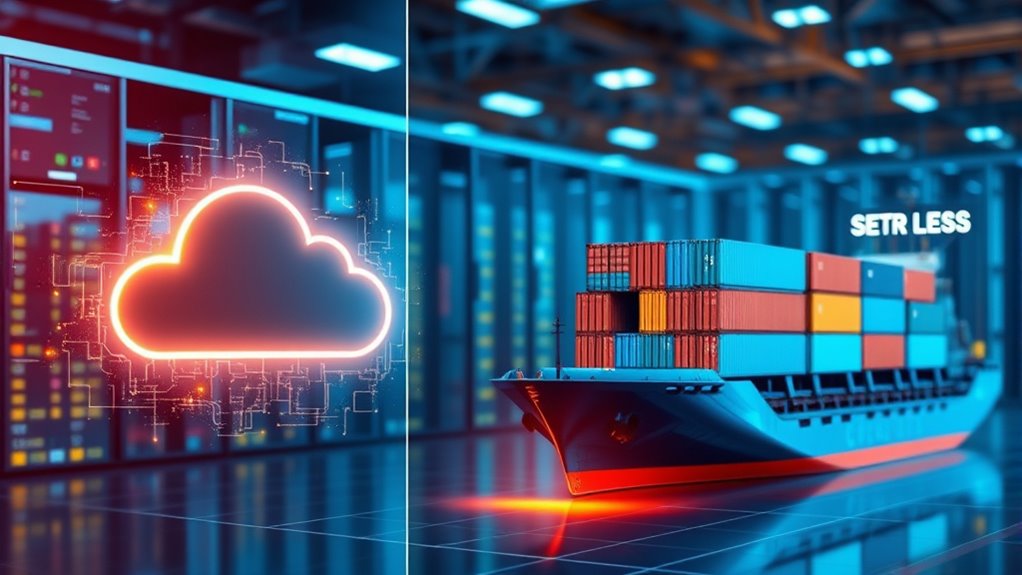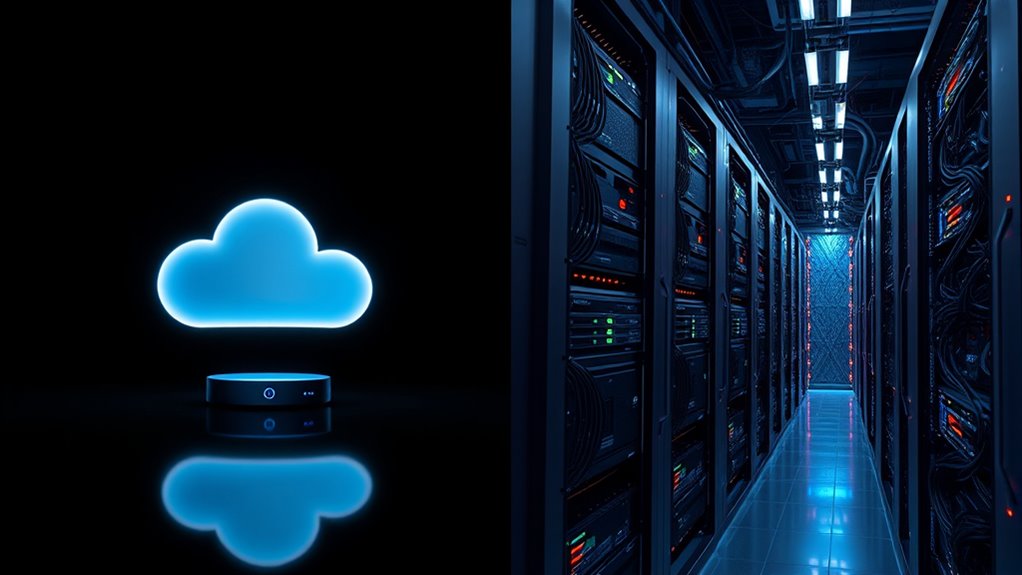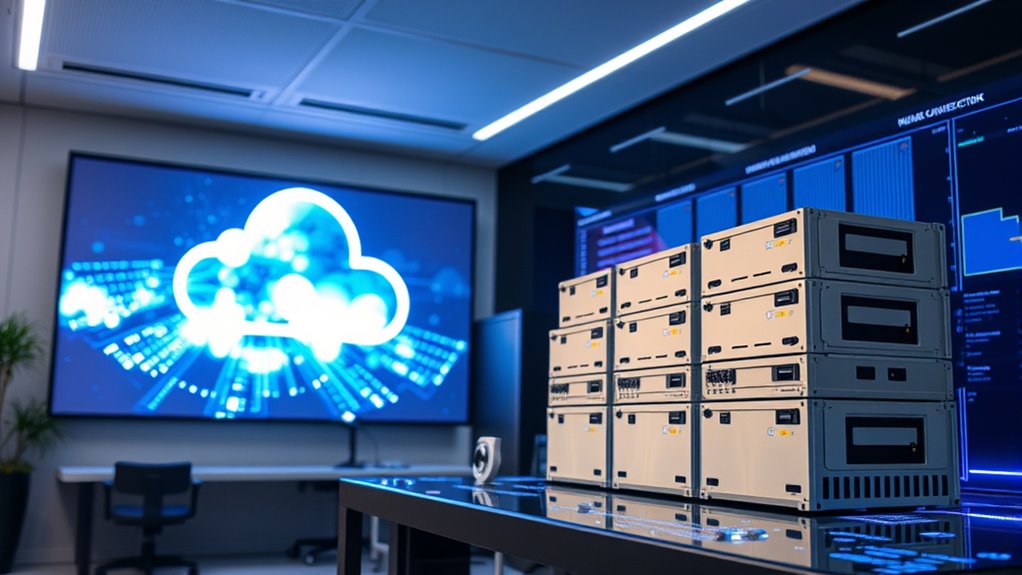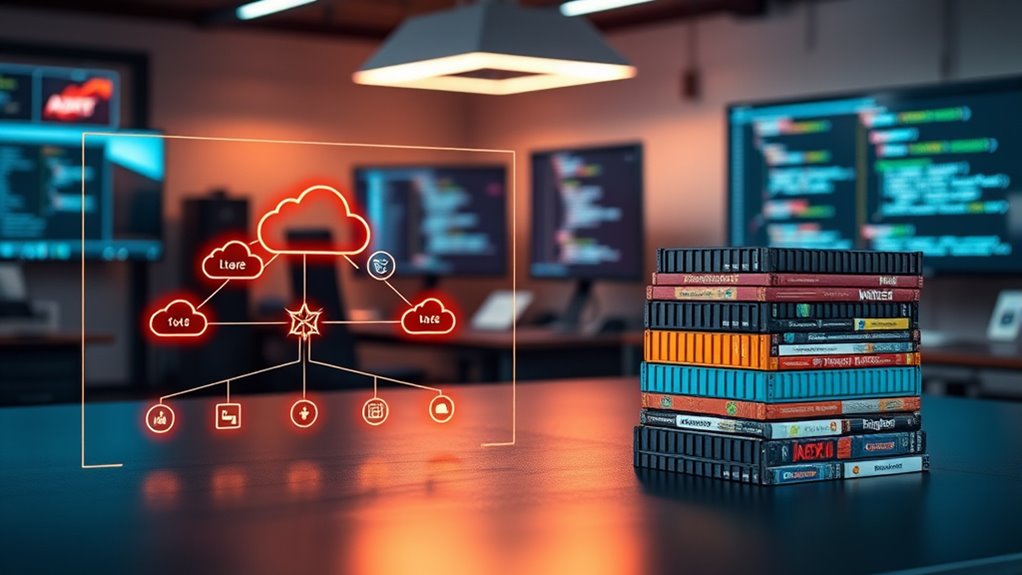Choose serverless when you want rapid development, easy scalability, and cost savings since you pay only for what you use. Opt for containers if you need fine control, custom environments, or to support legacy systems with specific hardware. Containers are also better for complex workflows and long-running processes. If you want to understand which option fits your workload and infrastructure needs better, keep exploring how each approach aligns with your goals.
Key Takeaways
- Choose serverless for rapid development, variable workloads, and minimal infrastructure management.
- Opt for containers when long-term control, customization, or complex hardware integration is required.
- Use serverless for event-driven, stateless applications with unpredictable traffic patterns.
- Deploy containers for applications needing persistent state, custom environments, or legacy system compatibility.
- Select containers if you need predictable costs, advanced networking, or specialized hardware support.
Understanding the Core Concepts of Serverless and Containerization

Understanding the core concepts of serverless and containerization is essential to grasp how modern applications are built and deployed. With serverless, your code runs in response to events, and the cloud provider manages infrastructure, enabling seamless function orchestration. This approach simplifies deployment and scaling but often leads to vendor lock-in, limiting your flexibility with providers. Containers, on the other hand, package applications along with their dependencies, creating portable units that run consistently across environments. They give you more control over the environment and avoid vendor lock-in, but require you to manage orchestration tools like Kubernetes. Both approaches fundamentally change how you develop and deploy applications, emphasizing efficiency and flexibility—understanding these core differences helps you choose the right solution for your needs.
When Scalability and Cost Efficiency Are Top Priorities

When scalability and cost efficiency are your top priorities, choosing the right deployment model becomes critical. Serverless architectures excel in cost optimization because you pay only for what you use, making them ideal for variable workloads. However, be aware of potential vendor lock-in, which can limit flexibility. Containers, on the other hand, offer predictable costs and easier migration across providers. Consider these key points:
- Serverless minimizes costs with automatic scaling but may increase vendor lock-in risks.
- Containers provide consistent performance and flexibility at potentially higher, but predictable, costs.
- For rapid growth and fluctuating demand, serverless offers seamless scalability; for long-term control, containers deliver more customization.
- The choice between them often depends on the deployment architecture and your specific workload requirements.
Choosing between them depends on balancing cost efficiency with your flexibility needs.
Situations Requiring Fine-Grained Control and Customization

When you need precise control over your environment, containers give you the flexibility to customize setups exactly to your specifications. You can tailor hardware choices and configure advanced networking to meet unique requirements. Serverless platforms, by contrast, often limit this level of fine-tuning, making containers the better choice for such scenarios. Additionally, creative practice can be enhanced by having control over your environment, allowing for experimentation and innovation tailored to specific needs.
Custom Environment Setup
In scenarios where you need precise control over your environment, serverless platforms often fall short because they limit customization options. When setting up a custom environment, containers give you the flexibility to define exactly what you need. Consider these situations:
- You require specific environment variables to configure your application precisely.
- You need to install custom software or dependencies not supported by serverless.
- You want to create a tailored environment that matches your development and production setups exactly.
- Knowledge of industry trends indicates that containers are favored for complex or highly specialized setups, ensuring consistent behavior across environments.
Specific Hardware Needs
Certain hardware requirements demand precise control and customization that serverless platforms can’t easily provide. If your application relies on specialized hardware or hardware acceleration, containers give you the flexibility to configure and optimize these components directly. This control is essential for workloads like machine learning, scientific computing, or multimedia processing, where hardware-specific features greatly boost performance. You might need to select GPUs, TPUs, or custom FPGA setups. Here’s a comparison:
| Feature | Serverless | Containers |
|---|---|---|
| Hardware customization | Limited, mostly abstracted | Full control over hardware setup |
| Hardware acceleration | Not easily accessible or configurable | Direct access to specialized hardware |
| Fine-grained control | Generally restricted | Complete control for optimization |
For such needs, containers stand out as the ideal choice. Additionally, understanding hardware-specific features is crucial for maximizing performance in specialized workloads.
Advanced Networking Configuration
Advanced networking configuration demands precise control over data flow, security policies, and traffic management. When your applications require advanced security and network isolation, you need fine-grained customization. Consider these situations:
- Implementing strict security policies to protect sensitive data
- Managing complex network traffic with custom routing rules
- Ensuring complete network isolation between services or tenants
- Incorporating antiques to create a unique and personalized environment within your network design.
In these cases, serverless solutions may fall short, making containers the better choice. Containers enable you to configure virtual networks, set up custom firewalls, and customize security groups to meet your specific needs. This level of control guarantees your network remains secure, isolated, and adaptable to complex requirements. Opt for containers when advanced security and precise network configuration are priorities.
Assessing Development Speed and Deployment Agility

When comparing serverless and container-based architectures, evaluating development speed and deployment agility reveals key differences that can impact your project timelines. Serverless platforms enable rapid development, as they handle much of the infrastructure setup, allowing you to focus on code. Deployment is streamlined with automatic scaling and minimal configuration, enhancing agility. Containers, however, may require more setup and configuration time, especially for complex environments, which can slow development initially. While containers offer greater control, they might also introduce vendor lock-in if tied to specific platforms. Cost optimization plays a role here: serverless often reduces expenses through pay-as-you-go models, but vendor lock-in can limit flexibility. Overall, serverless accelerates deployment, while containers provide more control at the cost of speed. Using top mattress toppers can improve rest during development phases, ensuring teams stay productive and alert.
Compatibility and Integration With Existing Infrastructure

When considering serverless or containers, you need to evaluate how well they fit with your existing systems. Legacy applications can pose compatibility challenges, requiring careful planning for integration. Additionally, managing the complexity of connecting new solutions to your current infrastructure can impact deployment speed and stability. With the increasing adoption of cloud services, understanding cloud security solutions and their integration needs becomes essential for maintaining secure and efficient operations.
Legacy System Compatibility
Legacy system compatibility plays a vital role in deciding between serverless and container-based architectures. Your existing infrastructure influences which approach fits best. Consider these key points:
- Compatibility with legacy systems determines if serverless can seamlessly integrate or if containers are needed for hardware integration.
- Containers often provide better support for legacy applications requiring specific hardware or OS configurations.
- Serverless may face challenges with legacy systems that depend on tightly coupled hardware or custom environments.
- When dealing with well-established systems, container solutions generally offer more flexibility for customization and hardware integration.
If your legacy setup involves specialized hardware or complex integration, containers offer more control. Conversely, if your legacy systems are adaptable, serverless can reduce overhead. Matching your legacy environment with the right architecture ensures smoother transitions and better long-term compatibility.
Integration Complexity Challenges
Integrating serverless and container-based architectures with existing infrastructure often presents complex challenges that can affect deployment and maintenance. Compatibility issues may arise, requiring updates to deployment automation processes to guarantee seamless operation. You’ll need to align security protocols across different platforms, which can be time-consuming and prone to errors. Container environments might demand specific configurations, while serverless functions may not support certain legacy systems, complicating integration efforts. Ensuring smooth data flow and communication between new and old components requires careful planning. Additionally, managing mixed environments increases complexity in monitoring and troubleshooting. You must evaluate how each architecture fits into your current infrastructure, balancing the benefits against potential integration hurdles to maintain security, efficiency, and operational stability. Considering remote hackathons can provide insights into overcoming these technical challenges through innovative collaborative solutions.
Handling State Management and Long-Running Processes

Handling state management and long-running processes presents a key difference between serverless architectures and containers. With serverless, managing state persistence can be tricky because functions are stateless by design, making long running tasks challenging. Containers, however, excel at maintaining persistent state and running long processes continuously. To help you decide:
Containers excel at persistent state management and long-running processes, unlike stateless serverless functions.
- State Persistence: Containers are better suited for applications needing consistent data storage across sessions.
- Long-Running Tasks: Containers can handle extended processes without interruption, unlike serverless functions which are limited in execution time.
- Workflow Complexity: For complex workflows requiring ongoing state updates, containers offer more control than stateless serverless functions.
- Juice cleanses and detoxification processes highlight the importance of nutrient-rich ingredients for effective health benefits, which can be managed more easily with persistent processes.
Choosing between them hinges on your application’s need for persistent state and handling prolonged processes efficiently.
Evaluating Maintenance, Monitoring, and Operational Overhead

When comparing serverless and container-based architectures, evaluating their maintenance, monitoring, and operational overhead is essential. With serverless, you benefit from reduced automation overhead since the provider manages much of the infrastructure. This simplifies maintenance but can lead to vendor lock-in, making it hard to switch providers or customize setups. Containers require more ongoing effort, as you’re responsible for managing updates, scaling, and monitoring tools. However, they offer greater flexibility and portability, reducing vendor lock-in risks. Monitoring containerized environments can be complex, needing additional tools for visibility. Additionally, understanding home improvement principles can help teams optimize their operational workflows for better efficiency. Ultimately, serverless minimizes operational overhead but at the cost of less control, while containers demand more effort but provide more customization. Consider your team’s expertise and long-term goals when weighing these factors.
Frequently Asked Questions
How Do Serverless and Containers Compare in Security Features?
When comparing security features, you should consider each option’s security posture and risk mitigation capabilities. Serverless platforms often provide built-in security measures, reducing your management burden but potentially limiting control. Containers give you more control over security configurations, allowing tailored risk mitigation strategies. Both require proper implementation, but serverless simplifies some security aspects, while containers demand active management to guarantee a robust security posture.
Which Option Offers Better Vendor Support and Community Resources?
When considering vendor support and community resources, you find that containers often have broader community resources due to their longer history. Vendors like Docker and Kubernetes provide extensive support, but serverless platforms like AWS Lambda or Azure Functions also offer dedicated support channels. Your choice depends on your needs; containers excel with robust communities, while serverless options offer specialized vendor support for quick troubleshooting and learning.
How Do Licensing and Compliance Considerations Differ Between Them?
Imagine a tightrope walker balancing carefully—licensing and compliance are your safety net. With serverless, you gain license flexibility, as the provider manages licensing, simplifying compliance standards. Containers, however, require you to handle licensing and guarantee your applications meet specific standards, offering more control but more responsibility. Your choice depends on how much control you want versus how much you prefer the provider to manage licensing and compliance issues.
What Are the Best Practices for Migrating Existing Applications?
You should start by evaluating your application’s architecture and determine if application refactoring is needed to optimize performance in the new environment. Focus on cost optimization strategies, such as containerization or serverless functions, to reduce expenses. Plan a phased migration, testing each component thoroughly. Keep documentation updated and involve your team early. This approach guarantees smooth shift, minimizes downtime, and aligns your application with best practices for scalability and efficiency.
How Do Updates and Patch Management Differ in Both Environments?
Think of updates and patches like tuning a musical instrument—you want it to stay in harmony. In serverless environments, deployment frequency is often high, with automatic updates handled seamlessly, reducing your manual effort. Containers require more deliberate configuration management and scheduled updates, making patching a bit more hands-on. You stay in control with containers, but serverless offers quicker, more automated updates, keeping your application running smoothly without missing a beat.
Conclusion
Choosing between serverless and containers is like picking the right vessel for your journey—swift sailboats for quick, flexible trips or sturdy ships for complex voyages. Consider your needs for control, cost, and speed. By understanding each option’s landscape, you can navigate confidently, steering your project to success. With the right choice, you’ll set sail smoothly across the vast ocean of modern deployment, reaching your destination efficiently and effortlessly.









